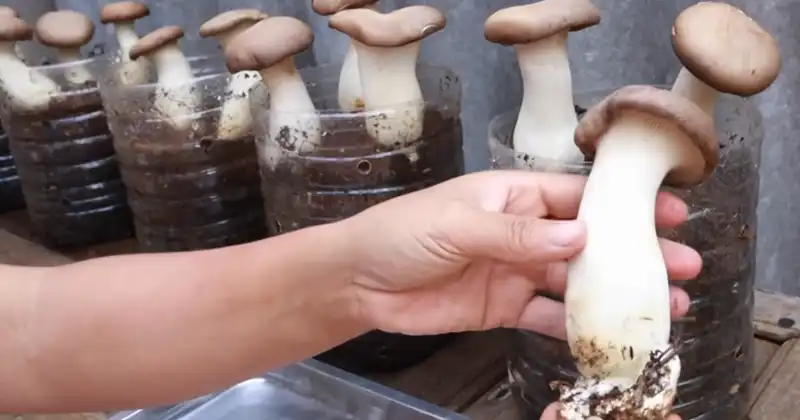Mushrooms, nature’s delightful fungi, can be a gourmet’s dream but often come with a hefty price tag at the local grocery store. Yet, cultivating your very own mushrooms at home is an affordable and eco-friendly endeavor. In this article, we’ll delve into a creative method for growing mushrooms using recycled 5L plastic bottles. By following these straightforward steps, you can enjoy a plentiful harvest of fresh mushrooms in just 45 days.
Materials and Equipment Required:
- Recycled 5L plastic bottles
- Straw
- Mushroom spores or mycelium
- Plastic wrap
- High-pressure watering can
- Soil and substrate
Step 1: Preparing the Bottles
Begin by selecting your 5L plastic bottles. Ensure they are thoroughly cleaned and sanitized to provide a clean slate for mushroom cultivation. Cut off the top section of each bottle while keeping the bottom intact, as it will serve as the container for your mushrooms.
Step 2: Straw Preparation
Straw makes an excellent growing medium for various mushroom species. Boil the straw to sterilize it and soften it. After boiling, allow it to cool and drain any excess water.
Step 3: Creating Air Holes
To facilitate proper air circulation, use a drill or a heated metal rod to create small holes all over the plastic bottles. Adequate ventilation is crucial for successful mushroom growth.
Step 4: Layering the Bottles
Layer the bottom of each plastic bottle with the boiled and cooled straw, creating a comfortable bed for your mushrooms. Ensure the straw is evenly spread and lightly packed.
Now, introduce the mushroom spores or mycelium onto the straw bed. Add another layer of straw on top to create a mixture of straw and mushroom spores within each bottle. This combination will serve as the growth medium for your mushrooms.
Step 5: Covering with Plastic Wrap
Place plastic wrap over the top of each bottle to create a semi-sealed environment. This cover helps to maintain humidity levels inside the bottle, promoting mycelium growth, which is essentially the mushroom’s root system.
Step 6: Initial Watering
Use a high-pressure watering can to gently moisten the straw and mushroom spores. This initial watering ensures the growing medium is adequately hydrated.
Step 7: Monitoring Growth
For the next 12 days, closely observe your bottles. You’ll begin to notice changes as the mycelium network expands within the straw. Once you observe signs of growth, it’s time to carefully remove the plastic wrap.
Step 8: Second Round of Watering
After removing the plastic wrap, continue to water your mushroom bottles regularly. This time, water directly into the bottle through the top opening, ensuring that the growing medium remains moist.
Step 9: Adding Soil and Substrate
Around 12-15 days after removing the plastic wrap, introduce a layer of soil and substrate to the top of each bottle. This mixture provides essential nutrients for the mushrooms as they enter the fruiting stage.
Step 10: Continued Watering and Growth
Keep watering the bottles as your mushrooms grow. In about 45 days, you’ll have fully grown mushrooms ready for harvest. It’s essential to maintain consistent humidity and moisture levels throughout the process for the best results.
Need more help? Watch this:
Growing mushrooms at home in recycled plastic bottles is an environmentally friendly and budget-friendly way to savor these delicious fungi. By diligently following these steps, you can transform your kitchen into a mushroom haven, providing a fresh and sustainable source of culinary delight right at your fingertips.
